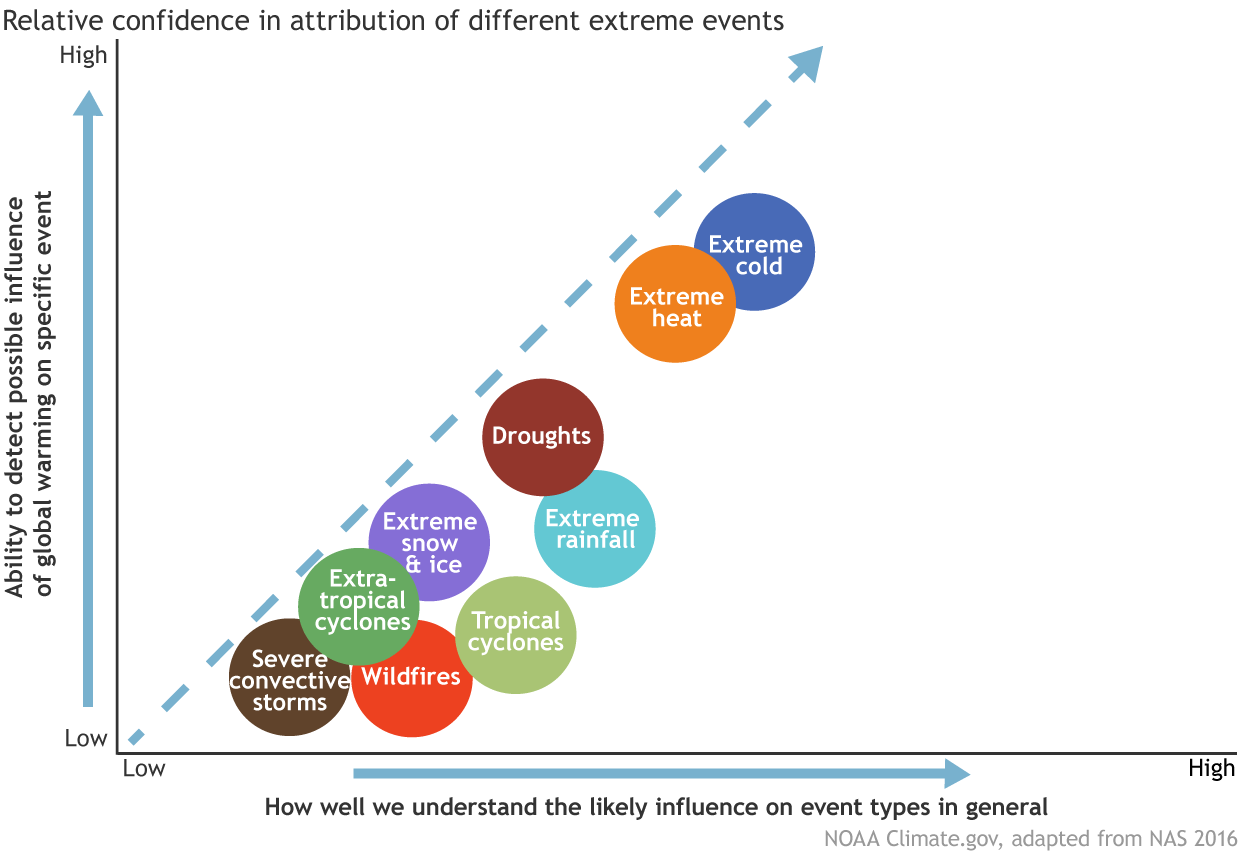
The New Science of Event Attribution
Mar 26, 2020
It has become increasingly common for the general media to say that weather-related disasters have been caused by climate change. Such headlines have largely been frowned upon by the scientific community as hyperbole because scientists could not say with confidence that any given weather-related event was the result of climate change. That’s beginning to change.
Advances in climate models and data science fed by a deeper physical understanding of the mechanisms that cause extreme weather events have opened up a relatively new branch of climate change science: the science of event attribution. This article discusses the approaches used in event attribution and how this new science may be applied in future.
The Triad of Observational Data, Climate Models, and Physical Understanding
Two approaches to event attribution—using observation data and climate models—are discussed below, although most studies typically use a combination of the two; a physical understanding of how weather events evolve and how a changing climate might impact that evolution is what give us confidence in our findings.
Observational Data
Extreme weather events are a natural part of Earth’s climate system. We have seen them throughout recorded history, and there is no reason to believe that we’ve seen the worst even in the absence of climate change. Extreme events are, by definition, rare, so observational data for them is naturally scarce in the short historical record and we should expect—and prepare—for loss records to be broken. This is why catastrophe models include correspondingly rare events that cause losses well above those in the historical record.
But what if extreme events are becoming more frequent, or more extreme, or both as a result of climate change? One way to determine that is to look at historical observation data to see whether there is an upward trend in the occurrence rates of extreme events. Lately, it seems as though “100-year”—or rarer—floods happen every year, but it’s important to understand that what is meant by a 100-year flood isn’t “a level of flooding that will happen only once every hundred years” but a level of flooding that has a 1% chance of happening every year in a particular location. For example, Hurricane Harvey broke many precipitation records and river levels in many locations: flood levels corresponded to astounding 100-, 200-, and 750-year return periods for river water level stages on Cypress Creek near Westfield, Greens Bayou near Houston, and on West Fork San Jacinto River near Porter, Texas, respectively.
In addition, the presence of long-period climate signals such as the Atlantic Multidecadal or Pacific Decadal Oscillations may influence an observed increase in frequency in storms rather than the impact of climate change, thus it is important to distinguish between the impact of climate change from climate variability. Climate models can help.
Climate Models
While we should expect records to be broken even under stable climate conditions—and even expect to see rare instances of clusters of extreme events—we should not expect the same records to be broken year after year, as in the case of global average surface temperatures, or even every few years. For each of the last three years, for example, the U.S. has experienced the wettest and slowest tropical cyclones on record for the locations they affected—Harvey (2017), Florence (2018), and Imelda (2019). And many of the most intense tropical cyclones on record, for example, have occurred in recent years, among them, Haiyan (2013), Pam (2015), Patricia (2015), Fantala (2016), Irma and Maria (2017), Michael (2018), and Fani and Dorian (2019).
If observational data seem to show a trend, we can investigate what’s driving that trend by trying to replicate it using general circulation, or climate models. By perturbing the models’ initial conditions (increasing greenhouse gas (GHG) concentrations, for example), model simulations can compare how weather-related extreme events develop and unfold in the presence or absence of rising temperatures. Conversely, our confidence in model output increases if we see results borne out in the observation data.
In fact, climate models do show an increase in the frequency of the most intense tropical cyclones (Categories 4 and 5) globally, although this varies by ocean basin and the results are far more ambiguous when it comes to overall frequency of all categories. Observation data appear to confirm what the models predict. Since 1980, storms with winds of 200 km/h or greater have more than doubled in frequency, while storms with winds of more than 250 km/h have tripled.
In a recent blog on the Australia bushfires, I discussed anomalies in large-scale atmospheric and oceanic circulation patterns that suppress precipitation and raise temperatures over that continent. Climate model simulations suggest that the frequency of these anomalies is increasing as a result of climate change. That is, hot, dry summers in Australia—the kind that lend themselves to bushfire ignitions—are likely to become more frequent as the Earth warms.
Climate models have also revealed a significant impact on the planetary-scale waves that are the result of the temperature difference between the poles and the equator. Because the poles are warming three times faster than the tropics, the temperature gradient is now flatter. This is causing these waves to become longer and slower—even to stall for days or weeks. Weather systems, which usually follow the steering currents within these waves, can become trapped, as Hurricane Harvey did when it dumped more than 60 inches of rain on Houston over about two days in August 2017.
Physical Understanding
There is a third criterion for increasing confidence that climate change has played a role in a particular event or class of events: physical understanding of natural phenomena. This understanding answers questions about why climate models and the historical records may be yielding the results they do. Some event types are easier to explain than others. Figure 1 shows that extreme temperature records (even cold ones) are the most easily explained, as they can be reliably reproduced by climate models and are frequently exhibited in the observational record. We therefore have the highest confidence that such events are influenced by climate change. Heavy precipitation events are the next easiest to explain, because a warmer atmosphere simply contains more water vapor; planetary waves can move more slowly due to reduced pole-equator temperature gradients; and weather systems can be more intense and squeeze more water vapor upward to condense and fall as rain. Drought events yield similar levels of climate change confidence, because the dry-pressure ridge of a slowly moving planetary wave can block precipitating systems from getting through. Tropical cyclones, winter storms, severe convective storms (thunderstorms), and even wildfire events, however, can be difficult to attribute to climate change because their ingredients are complex, and each may be influenced by climate change in competing ways. Severe convective storms are a good example. These storms need a lot of convective available potential energy (CAPE) to fuel them and moderate wind shear to tilt the storms vertically so that they can be long-lived. While climate change is increasing CAPE, it may also be weakening vertical wind shear. Thus, for any single event especially, it is difficult to say whether climate change played a role. Trying to make sense of how climate change influences the ingredients of a natural catastrophe in a holistic way is not helped by the fact that climate models cannot explicitly simulate the ingredients of the actual events, be they hail, tornado, or straight-line wind.
Quantifying the Impact of Climate Change
Until very recently, most event attribution studies attempted to determine the impact of climate change on classes of events, such as tropical cyclones, wildfires, severe thunderstorms, or floods. Some studies, however, now attempt to quantify the influence on individual events.
To do this, climate scientists often use statistical techniques similar to those used in epidemiology. The epidemiologist will calculate the attributable fraction (AF), or the proportion of people who contract a disease as a result of a risk factor present in the natural or occupational environment, or lifestyle choices. Today, climate scientists are deriving the fraction of attributable risk (FAR) using similar statistical techniques in combination with climate simulation models; FAR represents the proportion of adverse event risk attributable to the human influence on climate change or, conversely, the likelihood that an event would have happened in the absence of current greenhouse gas emissions.
While Hurricane Sandy's (2012) wind speeds and atypical westward track were the result of many different and complex factors, various event attribution studies have determined that the coastal flooding that resulted was more severe than it would have been if had Sandy occurred 50 years earlier, due to sea level rise. They estimate that the probability of a Sandy-like inundation continues to increase and that less intense storms will produce similar inundation levels in the future.
Shortly after Hurricane Harvey occurred in 2017, scientists determined through evaluation of observational data and long-term simulation using climate models that an event like Harvey had a 0.05% chance of occurring in a given year late last century, had something closer to a 0.3% chance in a given year when it occurred, and that by the end of this century it will have a 1% chance. Thus, in the time span of just 100 years, climate change will have increased the likelihood of that kind of flood event by a factor of 20—and has already increased it by a factor of six.

Looking Ahead
Extreme event attribution is still a relatively new branch of climate change science, demonstrating its usefulness in quantifying impacts of climate change on many temperature- and water-related extreme events. The special issues of The Bulletin that the American Meteorological Society has released at the end of each year going back to 2011 is still dominated by such events. Their latest issue highlights 20 extreme events in 2019: 10 temperature events and 7 precipitation events. As our knowledge of climate change impacts grows, as the science of event attribution matures, and as computers become faster, the expectation is that climate attribution studies will begin to focus on other types of extreme weather such as tropical cyclones, extratropical cyclones, severe convective storms, and wildfire.
 Peter Sousounis, Ph.D.
Peter Sousounis, Ph.D.